
Goat Meat
Coming Soon...
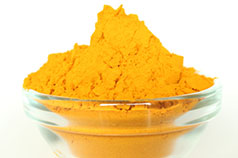
Turmeric Powder
Turmeric powder is a bright and deep yellow colored powder made by grinding dried underground stems of turmeric, which is starchy in nature. In India and some of its neighboring countries, turmeric in stem or powdered form has been used to color skin and clothing and to add color and aroma to food. It is also used as a pious powder during festivals and marriage ceremonies. In other parts of the world, turmeric is mainly used to add color and aroma to food. Turmeric has pungent and bitter taste but musky and mild fragrance.
Turmeric powder is made by steaming or boiling the underground stems in slightly alkaline water (measures above 7.0 on the pH scale) to precook the starch in turmeric. The alkaline water also improves the color of turmeric. Boiled turmeric stems are sun-dried and ground to make powder.
Turmeric powder is mainly used in curries, stir fried dishes, and dry rubs. It is also used in some spicy salad dressing and smoothies and drinks.
The compound called curcuminoids in turmeric is responsible for its yellow color and has antioxidant and preservative properties. Due to its antioxidant properties, use of turmeric in food helps prevent certain type of cancer, lowers cholesterol, lowers the risk of cardiovascular diseases, and protects from Alzheimer’s disease. Due to its preservative property, use of turmeric in food helps in extending the shelf-life of food.
Turmeric has also been used in Indian and Chinese system of medicine as an anti-inflammatory agent to treat various conditions such as toothache, bruises, chest pain, and digestion problems. In addition, turmeric contains very good amounts of minerals like iron, calcium, potassium, manganese, zinc, copper, and magnesium.
Store turmeric powder in a tightly sealed container in a cool, dark, and dry place. At room temperature, turmeric powder will taste fresh for 4 to 6 months. Refrigerate it for a longer shelf-life of up to 2 years.
Turmeric powder is available in Indian and South Asian grocery stores. Some of the popular brands of turmeric powder are Nirav, Deep, SWAD, Spicy World, and Jiva. You may also find it in supermarkets or gourmet markets. It is available at online grocery stores such as amazon.com, where you will be able to choose from several brands.
Turmeric powder is made by steaming or boiling the underground stems in slightly alkaline water (measures above 7.0 on the pH scale) to precook the starch in turmeric. The alkaline water also improves the color of turmeric. Boiled turmeric stems are sun-dried and ground to make powder.
Turmeric powder is mainly used in curries, stir fried dishes, and dry rubs. It is also used in some spicy salad dressing and smoothies and drinks.
The compound called curcuminoids in turmeric is responsible for its yellow color and has antioxidant and preservative properties. Due to its antioxidant properties, use of turmeric in food helps prevent certain type of cancer, lowers cholesterol, lowers the risk of cardiovascular diseases, and protects from Alzheimer’s disease. Due to its preservative property, use of turmeric in food helps in extending the shelf-life of food.
Turmeric has also been used in Indian and Chinese system of medicine as an anti-inflammatory agent to treat various conditions such as toothache, bruises, chest pain, and digestion problems. In addition, turmeric contains very good amounts of minerals like iron, calcium, potassium, manganese, zinc, copper, and magnesium.
Store turmeric powder in a tightly sealed container in a cool, dark, and dry place. At room temperature, turmeric powder will taste fresh for 4 to 6 months. Refrigerate it for a longer shelf-life of up to 2 years.
Turmeric powder is available in Indian and South Asian grocery stores. Some of the popular brands of turmeric powder are Nirav, Deep, SWAD, Spicy World, and Jiva. You may also find it in supermarkets or gourmet markets. It is available at online grocery stores such as amazon.com, where you will be able to choose from several brands.

Ginger
Native to Southeastern Asia, Ginger is popularly used as a spice and medicine in both eastern and western cultures. Ginger was used by ancient Romans and later, after the fall of Roman Empire, was traded in Europe by Arabs who took over the spice trade. Ginger became very expensive like other spices, and in medieval times, was traded in preserved form to make sweet treats.
For many years, ginger has been used to flavor a wide variety of food, from meats and sausages to fish and vegetables, and various curries as well as drinks and desserts. Fresh ginger can be used as sliced, crushed, or as paste.
Ginger has antioxidant and anti-inflammatory properties; therefore, it’s used in traditional medicine to cure a variety of ailments, such as, gastrointestinal distress, motion sickness, arthritis, and cold and flu. Cooking food with small quantity of ginger on a regular basis also adds to health benefits.
The distinct flavor and medicinal property of ginger comes from gingerols, shogaols, and zingerone. Fresh ginger contains gingerol an anti-inflammatory compound that is believed to help in reducing osteoarthritis or rheumatoid arthritis pain, if consumed on a regular basis. It may also prevent growth of certain cancer. Gingerol is transformed into shogaols when dried and cooked. Also, when ginger is cooked gingerol and shogaols is transformed into zingerone. Due to the presence of zingerone, food cooked with ginger has a sweet and spicy flavor. The anti-inflammatory and antioxidant properties of zingerone help in prevention and cure of many medical problems. Dry ginger alone has strong flavor due to shogaols used in many medicines as well as compliments cookies, cakes, and candies recipes, and tea and drinks.
In addition to the use for culinary and medicinal purposes, ginger is also used to fragrance many soaps and cosmetics.
Ginger is sold in many forms in supermarkets, such as fresh, dried, powdered, preserved, crystallized, and as oil. You will find ginger paste, a popular way of using ginger to make curries in Asian countries, in Asian and South Asian grocery stores. Be sure to use ginger in the recipe in the form it’s advised. For example, if a recipe calls for fresh ginger, it cannot be replaced with dry or powdered or other types. Each form of ginger has a distinct taste and different purpose.
Ginger is best stored as whole and unpeeled in a sealed plastic bag in refrigerator. If part of the ginger has been cut or peeled, be sure to dry it before storing. Other forms of ginger are mainly packaged and need to be stored as per instructions by the seller.
For many years, ginger has been used to flavor a wide variety of food, from meats and sausages to fish and vegetables, and various curries as well as drinks and desserts. Fresh ginger can be used as sliced, crushed, or as paste.
Ginger has antioxidant and anti-inflammatory properties; therefore, it’s used in traditional medicine to cure a variety of ailments, such as, gastrointestinal distress, motion sickness, arthritis, and cold and flu. Cooking food with small quantity of ginger on a regular basis also adds to health benefits.
The distinct flavor and medicinal property of ginger comes from gingerols, shogaols, and zingerone. Fresh ginger contains gingerol an anti-inflammatory compound that is believed to help in reducing osteoarthritis or rheumatoid arthritis pain, if consumed on a regular basis. It may also prevent growth of certain cancer. Gingerol is transformed into shogaols when dried and cooked. Also, when ginger is cooked gingerol and shogaols is transformed into zingerone. Due to the presence of zingerone, food cooked with ginger has a sweet and spicy flavor. The anti-inflammatory and antioxidant properties of zingerone help in prevention and cure of many medical problems. Dry ginger alone has strong flavor due to shogaols used in many medicines as well as compliments cookies, cakes, and candies recipes, and tea and drinks.
In addition to the use for culinary and medicinal purposes, ginger is also used to fragrance many soaps and cosmetics.
Ginger is sold in many forms in supermarkets, such as fresh, dried, powdered, preserved, crystallized, and as oil. You will find ginger paste, a popular way of using ginger to make curries in Asian countries, in Asian and South Asian grocery stores. Be sure to use ginger in the recipe in the form it’s advised. For example, if a recipe calls for fresh ginger, it cannot be replaced with dry or powdered or other types. Each form of ginger has a distinct taste and different purpose.
Ginger is best stored as whole and unpeeled in a sealed plastic bag in refrigerator. If part of the ginger has been cut or peeled, be sure to dry it before storing. Other forms of ginger are mainly packaged and need to be stored as per instructions by the seller.
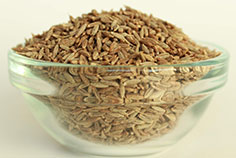
Cumin Seeds
Native to the Mediterranean regions and northern Africa, cumin has been cultivated for thousands of years in the Middle East, India, China and the Mediterranean. Cumin is one of the most consumed spices in the world.
Cumin is a drought tolerant and grows best in warm, dry climates. Ideal temperatures for growing cumin is between 77°F to 86°F. Depending on the location, cumin has a growing season of 3 to 4 months. The plant produces small white or pink flowers and dark green seed pods. The seeds are harvested when the plant starts to wilt and the seed pods changes from dark green to brownish yellow.
India has been the largest producer of cumin with around 75% of the total crop produced, followed by Syria, Turkey, Iran, and China.
Cumin is used to in various curry powders and spice blends to flavor dishes in India, Middle East, Mexico, Portugal, and Spain. Cumin adds nutty and spicy taste to the grilled meat, soups and stews, sausages, pickles, and rice and bean dishes. It is also used to make liqueur - an alcoholic drink consumed after meal. Oil of cumin is used in fragrances.
Cumin can be used as whole seed or in powdered form that are easily available in grocery stores or can be made at home by grinding the cumin seeds. Many people prefer to buy cumin seeds over powder because seeds last longer at room temperature and it’s very easy to ground cumin seeds into powder.
Cumin seeds last for about an year whereas cumin powder lasts for about six months at room temperature. Store the cumin seeds or powder in a tight lid jar in a cool, dark, and dry place. If you do not use it often in your cooking then keep the seeds or powder in the freezer to last up to 2 years.
In addition to adding flavor to the dishes, cumin helps in digestion and digestive problems. The essential oil in cumin activates the salivary glands in mouth that helps in primary digestion of food. The presence of essential oil, sodium, and magnesium in cumin provides relief from stomach aches. The essential oil in cumin also relieves stress and anxiety and helps inducing sleep. Presence of caffeine in combination with essential oil loosen up and eliminate mucus and phlegm in respiratory tract, which help to heal the initial condition leading to respiratory disorders such as asthma.
Packaged cumin seeds are available in Indian and South Asian grocery stores. Some of the popular brands of cumin seeds are SWAD, Frontier, Deep, and Nirav. You may also find it in supermarkets or gourmet markets. It is available at online grocery stores such as amazon.com, where you will be able to choose from several brands.
Cumin is a drought tolerant and grows best in warm, dry climates. Ideal temperatures for growing cumin is between 77°F to 86°F. Depending on the location, cumin has a growing season of 3 to 4 months. The plant produces small white or pink flowers and dark green seed pods. The seeds are harvested when the plant starts to wilt and the seed pods changes from dark green to brownish yellow.
India has been the largest producer of cumin with around 75% of the total crop produced, followed by Syria, Turkey, Iran, and China.
Cumin is used to in various curry powders and spice blends to flavor dishes in India, Middle East, Mexico, Portugal, and Spain. Cumin adds nutty and spicy taste to the grilled meat, soups and stews, sausages, pickles, and rice and bean dishes. It is also used to make liqueur - an alcoholic drink consumed after meal. Oil of cumin is used in fragrances.
Cumin can be used as whole seed or in powdered form that are easily available in grocery stores or can be made at home by grinding the cumin seeds. Many people prefer to buy cumin seeds over powder because seeds last longer at room temperature and it’s very easy to ground cumin seeds into powder.
Cumin seeds last for about an year whereas cumin powder lasts for about six months at room temperature. Store the cumin seeds or powder in a tight lid jar in a cool, dark, and dry place. If you do not use it often in your cooking then keep the seeds or powder in the freezer to last up to 2 years.
In addition to adding flavor to the dishes, cumin helps in digestion and digestive problems. The essential oil in cumin activates the salivary glands in mouth that helps in primary digestion of food. The presence of essential oil, sodium, and magnesium in cumin provides relief from stomach aches. The essential oil in cumin also relieves stress and anxiety and helps inducing sleep. Presence of caffeine in combination with essential oil loosen up and eliminate mucus and phlegm in respiratory tract, which help to heal the initial condition leading to respiratory disorders such as asthma.
Packaged cumin seeds are available in Indian and South Asian grocery stores. Some of the popular brands of cumin seeds are SWAD, Frontier, Deep, and Nirav. You may also find it in supermarkets or gourmet markets. It is available at online grocery stores such as amazon.com, where you will be able to choose from several brands.

Onion
Most researchers agree that onion has been cultivated for 5000 years or more, and they were first grown in central Asia. Others suggest that onions were first grown in Iran and western Pakistan. Onions can be grown in a variety of soils and climates and are less perishable; therefore, it is believed that they were domesticated simultaneously all over the world. It is interesting to know that Egyptians worshiped onions and believed that concentric rings of onions symbolize eternal life.
Due to pungent taste and smell, humans started onions to protect their plants from animals and insects. The strong flavor of onions comes from sulphur compounds, which onion plants absorb from soil when growing. When an onion is cut, certain enzyme breaks out producing strong sulphurous smell.
Cooking alters the strong and pungent taste of onions into meaty taste that adds flavor to various dishes in many cultures. Onions are also eaten in raw form to garnish many dishes. Cut onions can be rinsed properly to remove sulphur, when eaten raw. You can also put the onions in the freezer for 20-30 minutes to minimize the release of sulphurous smell and taste.
The sulphur compounds, flavonoids (antioxidants), and fructans (small carbohydrate molecules) help prevent cancer, stomach ulcer, and reduce symptoms of diabetes mellitus.
Whole dry onions should be stored at room temperature at dry place with proper ventilation. Do not store onions in closed plastic bags. Netted or punched bags are best to store whole onions for better ventilation, and last upto 4 weeks. Cut onions needs to be refrigerated. Cut onions stored in a sealed container can last up to a week.
Due to pungent taste and smell, humans started onions to protect their plants from animals and insects. The strong flavor of onions comes from sulphur compounds, which onion plants absorb from soil when growing. When an onion is cut, certain enzyme breaks out producing strong sulphurous smell.
Cooking alters the strong and pungent taste of onions into meaty taste that adds flavor to various dishes in many cultures. Onions are also eaten in raw form to garnish many dishes. Cut onions can be rinsed properly to remove sulphur, when eaten raw. You can also put the onions in the freezer for 20-30 minutes to minimize the release of sulphurous smell and taste.
The sulphur compounds, flavonoids (antioxidants), and fructans (small carbohydrate molecules) help prevent cancer, stomach ulcer, and reduce symptoms of diabetes mellitus.
Whole dry onions should be stored at room temperature at dry place with proper ventilation. Do not store onions in closed plastic bags. Netted or punched bags are best to store whole onions for better ventilation, and last upto 4 weeks. Cut onions needs to be refrigerated. Cut onions stored in a sealed container can last up to a week.

Salt
Salt is a mineral composed of a chemical compound called sodium chloride. It is essential for human body to regulate fluid balance and to control function of nerves and muscles. Human body cannot produce its own salt and depends on various sources of salt in food for necessary daily intake.
In addition to being just a diet supplement, salt helps in extracting the real flavors of savory as well as sweet dishes. No other seasoning has been found so fulfilling to replace salt. However, the overuse of salt results into a lot of health problems, such as hypertension, heart disease, and strokes. Use salt mildly in your food to you can enjoy its goodness.
In addition to being just a diet supplement, salt helps in extracting the real flavors of savory as well as sweet dishes. No other seasoning has been found so fulfilling to replace salt. However, the overuse of salt results into a lot of health problems, such as hypertension, heart disease, and strokes. Use salt mildly in your food to you can enjoy its goodness.
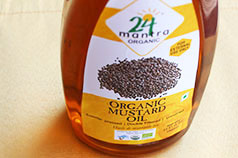
Mustard Oil
Coming Soon...
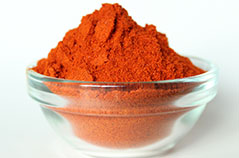
Red Chili Powder
Red chili powder is made by grinding dried deep red-brown thai chili peppers. Native to central and South America, red thai chili peppers were introduced to South Asia in 1500s and now India is the largest producer of these peppers in the world. Either in powdered or whole form, the chili peppers are used to add extra heat and spiciness to the dishes, which is due to the presence of a compound called capsaicin.
Red chili powder is a widely used spice for preparing a variety of curries, soups, stews, marinades, sauces, and dry rubs for barbecue. It is also used to flavor some sweet dishes such as cakes, brownies, truffles, and chocolates.
Red chili powder is a healthy seasoning. It contains significant amount of vitamin A and C, and beta carotenoids (a red-orange pigment that acts as an antioxidant and converts into vitamin A). It also helps to detoxify our body.
When purchasing red chili powder at store, look for the bright red colored powder for best taste. For making red chili powder at home:
Red chili powder is available in Indian and South Asian grocery stores. Some of the popular brands of red chili powder are Nirav, Deep, SWAD, Spicy World, and Everest. You may also find it in supermarkets or gourmet markets. It is available at online grocery stores such as amazon.com, where you will be able to choose from several brands.
Red chili powder is a widely used spice for preparing a variety of curries, soups, stews, marinades, sauces, and dry rubs for barbecue. It is also used to flavor some sweet dishes such as cakes, brownies, truffles, and chocolates.
Red chili powder is a healthy seasoning. It contains significant amount of vitamin A and C, and beta carotenoids (a red-orange pigment that acts as an antioxidant and converts into vitamin A). It also helps to detoxify our body.
When purchasing red chili powder at store, look for the bright red colored powder for best taste. For making red chili powder at home:
- Buy dry (not fresh) whole red thai chili peppers and remove the stems.
- Further dry the chili peppers in sun for a couple of days or slightly roast them for 2-3 minutes, without oil in a pan. Drying or roasting removes moisture from the chili peppers and adds extra crispness, which is required to powder them. Roasting the chili peppers enhances its flavor and aroma.
- Let the dried or roasted chili peppers cool down and then grind to a fine powder in a spice grinder. You can also use a coffee grinder for this purpose; however, the coffee grinder should be used for grinding spices only. It is not advisable to use the same grinder for spices and coffee.
Red chili powder is available in Indian and South Asian grocery stores. Some of the popular brands of red chili powder are Nirav, Deep, SWAD, Spicy World, and Everest. You may also find it in supermarkets or gourmet markets. It is available at online grocery stores such as amazon.com, where you will be able to choose from several brands.

Garlic Cloves
Native to central Asia, Garlic is one of the earliest plants that human used for flavoring food dishes as well as maintaining a good health. Garlic became an important ingredient in cooking many dishes in various parts of the world, such as, Asian countries including Middle East, northern Africa, southern Europe, and parts of South and Central America. However, Garlic was not popular in the USA until the beginning of twentieth century. By the year 1940, Americans recognized the importance of Garlic and started using it to season various recipes.
A Garlic bulb is a bunch of individual segments called cloves (like an orange segment). Each Garlic clove can be separated off the bunch and peeled before use to flavor any recipe. A Garlic clove can be used as a whole, sliced, crushed, or in the form of paste. Each way of using Garlic provides a different flavor to the recipes. For example, whole and sliced garlic provides mild taste than crushed and paste form.
Due to higher concentration of fructose and significantly less water content, Garlic is browned quickly when frying or roasting. Therefore, Garlic needs to be cooked carefully. If you are cooking food in a pan or a wok, one way is to add Garlic toward the end of cooking, in the last few minutes. However, Garlic added at the end of the cooking will provide a stronger taste. Some people like it, some don’t. Cooking Garlic at the beginning will mellow down the strong taste. To add garlic at the beginning of cooking and yet prevent from burning, cook the Garlic at a low heat and preferably in a smaller pan or wok. You can change the heat from low to medium after adding other ingredients with garlic. Garlic cooked this way will provide mild taste to the food. Garlic is best roasted in an oven by wrapping the cloves or whole bulb in an aluminum foil at 400 degrees Fahrenheit for about 40 minutes.
Though garlic is best known for flavoring food, it has also been used to maintain good health and for increasing strength. Usage of garlic in food may also help prevent many heart and blood system related conditions, such as, high blood pressure, high cholesterol, and coronary heart disease. It’s also believed that consumption of garlic on a regular basis reduces the risk of getting certain cancer, such stomach cancer, colon cancer, and lung cancer. For maximum health benefits, slice, crush, or make garlic paste 10 minutes before cooking. When a garlic clove is broken down, the ruptured cell releases the sulphur-based compound, alliin and an enzyme called alliinase. They come in contact with each other to form a new compound called alliicin, which is responsible for medicinal properties of Garlic. Allowing the cut Garlic to sit for about 10 minutes before cooking provides maximum health benefits due to optimal synthesis of alliicin.
Whole fresh garlic should be stored at room temperature at dry and dark place with proper ventilation. Do not store garlic in closed plastic bags. It’s best to store garlic in netted or punched bags for better air circulation. Refrigeration or freezing changes the texture and flavor of garlic. However, cut or peeled garlic needs to sealed in a container or air tight bag and refrigerated for later use.
A Garlic bulb is a bunch of individual segments called cloves (like an orange segment). Each Garlic clove can be separated off the bunch and peeled before use to flavor any recipe. A Garlic clove can be used as a whole, sliced, crushed, or in the form of paste. Each way of using Garlic provides a different flavor to the recipes. For example, whole and sliced garlic provides mild taste than crushed and paste form.
Due to higher concentration of fructose and significantly less water content, Garlic is browned quickly when frying or roasting. Therefore, Garlic needs to be cooked carefully. If you are cooking food in a pan or a wok, one way is to add Garlic toward the end of cooking, in the last few minutes. However, Garlic added at the end of the cooking will provide a stronger taste. Some people like it, some don’t. Cooking Garlic at the beginning will mellow down the strong taste. To add garlic at the beginning of cooking and yet prevent from burning, cook the Garlic at a low heat and preferably in a smaller pan or wok. You can change the heat from low to medium after adding other ingredients with garlic. Garlic cooked this way will provide mild taste to the food. Garlic is best roasted in an oven by wrapping the cloves or whole bulb in an aluminum foil at 400 degrees Fahrenheit for about 40 minutes.
Though garlic is best known for flavoring food, it has also been used to maintain good health and for increasing strength. Usage of garlic in food may also help prevent many heart and blood system related conditions, such as, high blood pressure, high cholesterol, and coronary heart disease. It’s also believed that consumption of garlic on a regular basis reduces the risk of getting certain cancer, such stomach cancer, colon cancer, and lung cancer. For maximum health benefits, slice, crush, or make garlic paste 10 minutes before cooking. When a garlic clove is broken down, the ruptured cell releases the sulphur-based compound, alliin and an enzyme called alliinase. They come in contact with each other to form a new compound called alliicin, which is responsible for medicinal properties of Garlic. Allowing the cut Garlic to sit for about 10 minutes before cooking provides maximum health benefits due to optimal synthesis of alliicin.
Whole fresh garlic should be stored at room temperature at dry and dark place with proper ventilation. Do not store garlic in closed plastic bags. It’s best to store garlic in netted or punched bags for better air circulation. Refrigeration or freezing changes the texture and flavor of garlic. However, cut or peeled garlic needs to sealed in a container or air tight bag and refrigerated for later use.
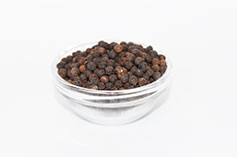
Whole Black pepper
Coming Soon...
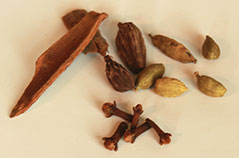
Whole Garam Masala
An authentic garam masala is a collection of four spices either in whole or powdered form. The four spices, green cardamom, black cardamom, clove, and cinnamon stick added in the right proportion enhances the flavor and aroma of the dishes. The word ‘garam’ means warm or hot and ‘masala’ means spice; however, garam masala does not mean that the spices are hot. It means that the spices raise your body temperature by increasing the metabolism. The taste of garam masala in food is intense (not hot) yet pleasant.
Either in whole or powdered form, it is an essential ingredient in many Indian and South Asian cuisine. The whole garam masala is usually added to the hot oil before other ingredients to release its flavor to the oil. On the other hand, the garam masala powder is added to the dishes with other powdered spices while cooking or just for seasoning the dishes toward the end of the cooking. Garam masala is used to flavor a variety of curries, stews, and soups and marinades and rubs for barbecue. Green cardamom, cinnamon, and clove are used to flavor a wide range of desserts.
Store the whole or powdered garam masala in a tight lid jar in a cool, dark, and dry place. It will last for about six months at room temperature. If you do not use it often in your cooking then keep it in the freezer to last up to 2 years.
In addition to the adding wonderful flavor and aroma to the food, garam masala helps in boosting metabolism and promoting weight loss. It helps in absorbing nutrients and lowering blood sugar. It also helps in detoxification.
You can buy whole or powdered garam masala at any Indian or South Asian grocery store or gourmet markets.
Either in whole or powdered form, it is an essential ingredient in many Indian and South Asian cuisine. The whole garam masala is usually added to the hot oil before other ingredients to release its flavor to the oil. On the other hand, the garam masala powder is added to the dishes with other powdered spices while cooking or just for seasoning the dishes toward the end of the cooking. Garam masala is used to flavor a variety of curries, stews, and soups and marinades and rubs for barbecue. Green cardamom, cinnamon, and clove are used to flavor a wide range of desserts.
Store the whole or powdered garam masala in a tight lid jar in a cool, dark, and dry place. It will last for about six months at room temperature. If you do not use it often in your cooking then keep it in the freezer to last up to 2 years.
In addition to the adding wonderful flavor and aroma to the food, garam masala helps in boosting metabolism and promoting weight loss. It helps in absorbing nutrients and lowering blood sugar. It also helps in detoxification.
You can buy whole or powdered garam masala at any Indian or South Asian grocery store or gourmet markets.

Water
Coming Soon...
Share your thoughts and questions!


